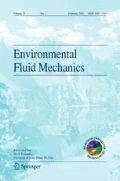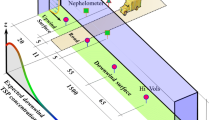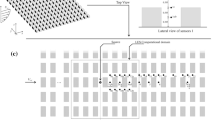Abstract
The strong fluctuating component in the measured concentration time series of a dispersing gaseous pollutant in the atmospheric boundary layer, and the hazard level associated to short-term concentration levels, demonstrate the necessity of calculating the magnitude of turbulent fluctuations of concentration using computational simulation models. Moreover the computation of concentration fluctuations in cases of dispersion in realistic situations, such as built-up areas or street canyons, is of special practical interest for hazard assessment purposes. In this paper, the formulation and evaluation of a model for concentration fluctuations, based on a transport equation, are presented. The model is applicable in cases of complex geometry. It is included in the framework of a computational code, developed for simulating the dispersion of buoyant pollutants over complex geometries. The experimental data used for the model evaluation concerned the dispersion of a passive gas in a street canyon between 4 identical rectangular buildings performed in a wind tunnel. The experimental concentration fluctuations data have been derived from measured high frequency concentrations. The concentration fluctuations model is evaluated by comparing the model's predictions with the observations in the form of scatter plots, quantile-quantile plots, contour plots and statistical indices as the fractional bias, the geometrical mean variance and the factor-of-two percentage. From the above comparisons it is concluded that the overall model performance in the present complex geometry case is satisfactory. The discrepancies between model predictions and observations are attributed to inaccuracies in prescribing the actual wind tunnel boundary conditions to the computational code.
Similar content being viewed by others
References
Csanady, G.T.: 1967, Concentration fluctuations in turbulent diffusion, J. Atmos. Sci. 24, 21-28.
Chatwin, P.C. and Sullivan, P.J.: 1979, Measurements of concentration fluctuations in relative turbulent diffusion, J. Fluid Mech. 94, 83-101.
Chatwin, P.C.: 1982, The use of statistics in describing and predicting the effects of dispersing clouds, J. Hazard. Mater. 6, 213-230.
Wilson, D.J., Robins, A.G. and Fackrell, J.E.: 1982, Predicting the spatial distribution of concentration fluctuations from a ground level source, Atmos. Environ. 16, 497-504.
Venkatram, A.: 1988, Topics in applied dispersion modelling. In: A. Venkatram and J.C. Wyngaard (eds.), Lectures on Air Pollution Modelling, pp. 267-324, American Meteorological Society, Boston.
Gifford, F.: 1959, Statistical properties of a fluctuating plume dispersion model, Adv. Geophys. 6, 117-137.
Hanna, S.R.: 1984, Concentration fluctuations in a smoke plume, Atmos. Environ. 18, 1091-1106.
Reynolds, A.M.: 2000, Representation of internal plume structure in Gifford's meandering plume model, Atmos. Environ. 34, 2539-2545.
Luhar, A.K., Hibbert, M.F. and Borgas M.S.: 2000, A skewed meandering plume model for concentration statistics in the convective boundary layer, Atmos. Environ. 34, 3599-3616.
Yee, E. and Wilson, D.J.: 2000, A comparison of the detailed structure in dispersing tracer plumes measured in grid-generated turbulence with a meandering plume model incorporating internal fluctuations, Boundary-Layer Meteorol. 94, 253-296.
Mole, N., Clarke, E.D. and Rietzler, E.: 1997, Modelling concentration fluctuation moments for spherically symmetric mean concentration, Il Nuovo Cimento 20, 399-411.
Mole, N.: 2001, The large time behaviour in a model for concentration fluctuations in turbulent dispersion, Atmos. Environ. 35, 833-844.
Lewis, D.M.: 1999, A simple model for concentration fluctuations in neutrally buoyant clouds, Boundary-Layer Meteorol. 90, 117-153.
Lewis, D.M. and Chatwin, P.C.: 1995, A new model pdf for contaminants dispersing in the atmosphere, Environmetrics 6, 583-593.
Yee, E. and Chan, R.: 1997, A simple model for the probability density function of concentration fluctuations in atmospheric plumes, Atmos. Environ. 31, 991-1002.
Du, S., Wilson, D.J. and Yee, E.: 1999, A stochastic time series model for threshold crossing statistics of concentration fluctuations in non-intermittent plumes, Boundary-Layer Meteorol. 92, 229-241.
Hilderman, T.L. and Wilson, D.J.: 1999, Simulating concentration fluctuation time series with intermittent zero periods and level dependence derivatives, Boundary-Layer Meteorol. 91, 451-482.
Donaldson, C. duP.: 1973, Construction of a dynamic model for the production of atmospheric turbulence and the dispersal of atmospheric pollutants. In: D.A. Haugen (ed.), Workshop on Micrometeorology, pp. 313-392, American Meteorological Society, Boston.
Fackrell, J.E. and Robins, A.G.: 1982, Concentration fluctuations and fluxes in plumes from point sources in a turbulent boundary layer, J. Fluid Mech. 117, 1-26.
Sykes, R.I., Lewellen, W.S. and Parker, S.F.: 1984, A turbulent-transport model for concentration fluctuations and fluxes, J. Fluid Mech. 139, 193-218.
Bartzis, J.G: 1989, Turbulent diffusion modelling for wind flow and dispersion analysis, Atmos. Environ. 23, 1963-1969.
Grigoriadis, D.G.E. and Robins, A.: 2001, Dispersion of passive pollutants at urban street canyon intersections, Technical Report, Dept. of Mechanical Engineering, University of Surrey, U.K.
Hanna, S.R. and Chang, J.C.: 1995, Comparison of predictions of the Hybrid Plume Dispersion Model with observations at the Kincaid power plant, Int. J. Environ. Pollut. 5, 323-330.
Olesen, H.R.: 1995, The model validation exercise at Mol: Overview of results, Int. J. Environ. Pollut. 5, 761-784.
Hanna, S.R.: 1993, Uncertainties in air quality model predictions, Boundary-Layer Meteorol. 62, 3-20.
Hanna, S.R., Chang, J.C. and Strimaitis, D.G.: 1993, Hazardous gas model evaluation with field observations, Atmos. Environ. 27A, 2265-2285.
Author information
Authors and Affiliations
Rights and permissions
About this article
Cite this article
Andronopoulos, S., Grigoriadis, D., Robins, A. et al. Three-Dimensional Modelling of Concentration Fluctuations in Complicated Geometry. Environmental Fluid Mechanics 1, 415–440 (2001). https://doi.org/10.1023/A:1015705615846
Issue Date:
DOI: https://doi.org/10.1023/A:1015705615846




